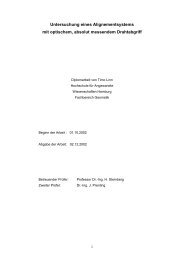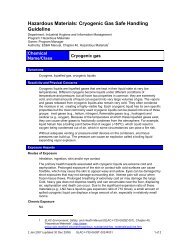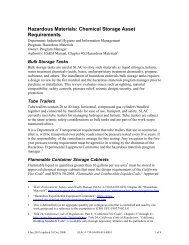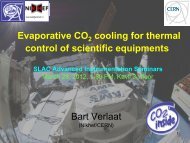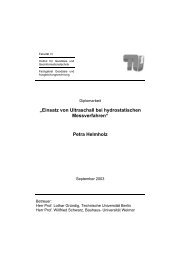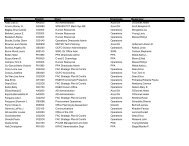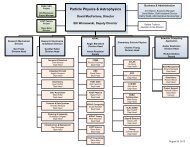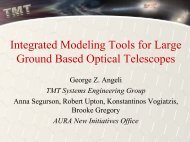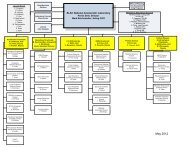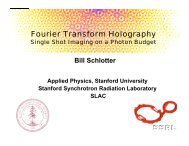BES - SLAC Group/Department Public Websites - Stanford University
BES - SLAC Group/Department Public Websites - Stanford University
BES - SLAC Group/Department Public Websites - Stanford University
You also want an ePaper? Increase the reach of your titles
YUMPU automatically turns print PDFs into web optimized ePapers that Google loves.
FYO7 <strong>SLAC</strong> S CIENCE AND T ECHNOLOGY S ELF E VALUATION<br />
function of the bias energy; (2) Proposed a way to eliminate spin decay in semiconductors due to<br />
spin-orbit coupling, in the process discovering a new type of SU(2) spin rotation symmetry. Both the<br />
theory and the experimental papers have been published in Phys. Rev. Lett.; (3) Predicted a new<br />
topological quantum phase transition between a conventional insulator and a Quantum Spin Hall<br />
state. The latter is characterized by a single pair of helical edge states. The group proposed to look<br />
for this effect in HgTe/CdTe semiconductor quantum wells. This paper has been published in<br />
Science.<br />
Using Local Probes for the Study of Nanoscale Phenomena in Complex Materials (A.<br />
Kapitulnik, H. Manoharan, K.A. Moler): In magneto optics, the Polar Kerr effect (PKE) in the<br />
spin-triplet superconductor Sr2RuO4 was measured with high precision using a Sagnac interferometer<br />
with a zero-area Sagnac loop. This material is presently of wide interest to the theory community as<br />
both an unconventional superconductor and a candidate material for quantum computation. PKE is<br />
sensitive to time reversal symmetry (TRS) breaking since it measures the existence of an<br />
antisymmetric contribution to the real and imaginary parts of the frequency-dependent dielectric<br />
tensor. Our results imply a broken time reversal symmetry state in the superconducting state<br />
Sr2RuO4. While our experiment determines that TRS is broken, coupled with other experiments it is<br />
strong evidence in favor of p+ip order parameter. Physics Today and Science featured the results. In<br />
Magnetic Imaging, a He-3 based scanning Hall probe microscope with a new generation of Hall<br />
probes with 100 nm spatial resolution was developed. An instrumentation paper on this topic was<br />
submitted to Applied Physics Letters. In High Resolution STM Studies, we observed the<br />
propagation of localized phonon modes through a 2D electron gas on the surface of Cu(111) by using<br />
molecular impurities, atomic manipulation, and inelastic tunneling spectroscopy. In addition,<br />
inelastic tunneling measurements were performed on diamondoid solids to look for vibrational<br />
structure. Mapping of electronic structure of diamondoid monolayers as a function of molecule<br />
packing arrangement was completed. In the area of scanning tunneling spectroscopy (STS) on<br />
ordered electronic structures, we used STS to study the unidirectional CDW system TbTe3. Using<br />
large area scans in a wide range of bias-voltage, a previous ambiguity was resolved regarding the size<br />
of the CDW wave-vector. Evidence was shown of the fully incommensurate nature of the CDW.<br />
Topographic data at different bias-voltage highlight two spontaneous symmetry-breaking effects in<br />
breaking the lattice point group symmetry by forming the 1D CDW, and the effect of dimerization,<br />
both demonstrated in real space for the first time.<br />
Behavior of Charges, Excitons and Plasmons at Organic/Inorganic Interfaces (M. D. McGehee,<br />
N. Melosh, M. Brongersma): As electronic device dimensions shrink to nanometer scales and the<br />
range of desirable applications grows, two trends are emerging. First, the range of materials under<br />
serious development is growing and many device structures consist of both organic and inorganic<br />
building blocks. Second, many physical phenomena that were heretofore only observed within<br />
academic experiments are becoming important for technologically relevant devices. Consequently,<br />
many technical issues need to be solved before these new possibilities become technologically<br />
viable. These include reproducible device performance on this length scale, sample heterogeneity,<br />
interface state control, defect properties, thermal transport and surface roughness. In addition,<br />
physical phenomena such as electron tunneling, Förster coupling, and plasmon-excitation quenching<br />
begin to severely impact device behavior at length scales less than 10 nm. This is particularly true<br />
within the emerging subset of structures that utilize both organic and inorganic materials, such as<br />
solar cells, electronic paper, molecular electronics, and organic light emitting displays. Our team has<br />
identified the need to understand excited state behavior within organic species close to inorganic<br />
surfaces as a key problem for future applications of these materials.<br />
Excited state phenomena within organic materials are often complicated by the multiple length<br />
scales, morphology, multiple competing decay processes, and inorganic surface interactions that<br />
affect the overall behavior of the system. Current studies of realistic devices are complicated by<br />
simultaneous excitation decay via a number of different processes within different regions of the<br />
F I N A L P A G E 2 7



